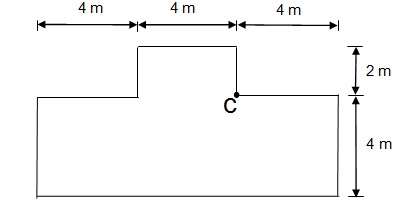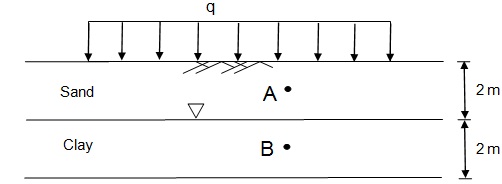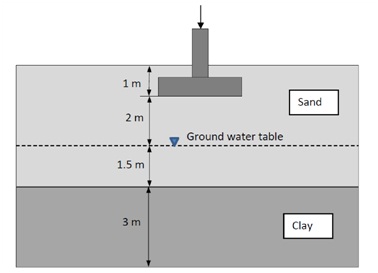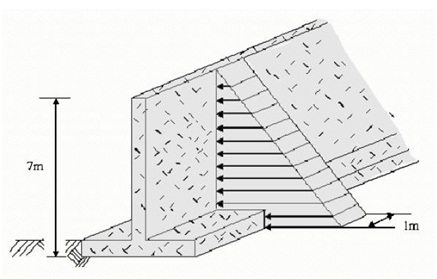Problem 1: Figure shows the layout of a foundation for a building which transmits a uniform pressure of 11-102 kPa on the soil surface. Figure shows the soil stratigraphy and table gives the soil properties.
a) Determine the stresses at point A which is directly below point C and at the midpoint of the sand stratum.
b) Determine the stresses at point B which is directly below point C and at the midpoint of the clay stratum.
c) Calculate the immediate settlement of the foundation at point C; the Young's modulus of the sand and clay are 4 MPa and 1 MPa respectively.


|
Soil layer
|
Dry Unit Weight
|
Saturated Unit Weight
|
Young's modulus
|
|
|
|
|
(kN/m3)
|
(kN/m3)
|
(MPa)
|
|
Sand
|
16
|
19
|
4
|
|
Clay
|
18
|
20
|
1
|
Problem 2: Table below lists data obtained from consolidated undrained triaxial tests on soft clay.
|
Tests
|
Cell pressure
|
Deviator stress at failure
|
Pore water pressure at failure
|
|
|
|
|
(kPa)
|
(kPa)
|
|
|
|
|
(kPa)
|
|
|
|
1
|
211
|
118
|
110
|
|
2
|
411
|
240
|
220
|
|
3
|
611
|
352
|
320
|
Assuming the unit weight of water is equal to 10 kN/m3:
a) Draw the Mohr circle of effective stress.
b) Determine the shear strength parameters in terms of effective stress.
c) Plot the critical state line and determine the critical state parameter M.
Problem 3: Figure shows a square footing of dimensions 1 m x 1 m which supports a column load of 11.102 kN. The footing is founded at 1 m below the ground surface. The properties of the soil are given in Table 4. The clay is normally consolidated. The ground water table is 3 m below the ground surface and the unit weight of water is 9.81kN/m3. Calculate the consolidation settlement of the clay layer that will result from the column's load carried by the footing.

|
Soil layer
|
Dry Weight kN/m3
|
Unit
|
Saturated Weight kN/m3
|
Unit
|
Specific Gravity
|
Compression index (Cc)
|
|
Sand
|
16
|
|
19
|
|
2.6
|
-
|
|
Clay
|
18
|
|
20
|
|
2.8
|
0.27
|
Problem 4: The gravity retaining wall shown in Figure 5 has a height of 7 m and a horizontal backfill of dry sand with a unit weight of 17.2 kN/m3 and an angle of friction of 41º. The retaining wall is cast in situ concrete with an angle of interface friction of 20º.
a) Calculate the magnitude of active and passive pressures upon a length of wall equal to 11 m using Rankine's method.
b) Plot the active pressure distribution with depth.

Just put your feet up and relax! Our Stress point of the Sand Stratum Assignment Help service delivers you a well-drafted and well-researched assignment paper, which will surely accomplish your dream grades.
Tags: Stress point of the Sand Stratum Assignment Help, Stress point of the Sand Stratum Homework Help, Stress point of the Sand Stratum Coursework, Stress point of the Sand Stratum Solved Assignments, Mohr Circle of Effective Stress Assignment Help, Mohr Circle of Effective Stress Homework Help, Mohr Circle of Effective Stress Coursework